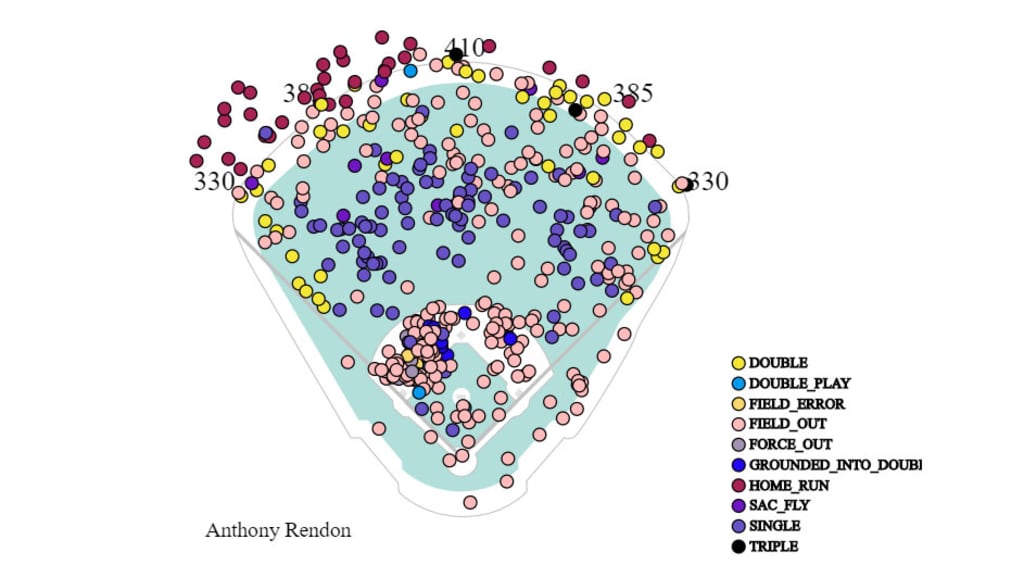Looking for consistent success on the free-agent market? Look no further than third baseman Anthony Rendon, who’s 29 and facing the open market for the first time.
Why do we mention consistency? Well, we can start with Rendon’s expected batting average (xBA), which is based on quality of contact (per Statcast) and strikeouts. Essentially, it tells us what the player’s batting average should have been, disregarding factors such as defense.
When we say consistency in xBA, it’s not just that the stat itself has remained the same, but also that it’s been quite close to his actual batting average. In 2019, Rendon hit .319, the best mark of his career. That’s great -- but what did his expected batting average say? Should he have hit .290 or .340 instead? No, his xBA was .319 -- the exact same value. Rendon was the only qualified hitter in 2019 to have his batting average be equal to his xBA.
This isn’t the first time Rendon’s batting average and xBA have been so close. In 2018, he hit .308 with an xBA of .307. He’s the only qualified hitter to have an xBA gap of no more than .001 in both years.
A player having an actual batting average that’s similar to his expected metric tells us that he is hitting the way he “should” be. But Rendon isn’t hitting .215 with an xBA of .215 -- he’s doing it in the above-.300 range. In other words, this is a player who hasn’t just been consistent, but consistently excellent.
Contrast that to players whose actual average significantly outpaces their xBA. For example, the seven players with the largest gaps between those two metrics in 2018 (all more than 30 points) each saw his actual production drop in '19, by an average of 46 points. That includes Scooter Gennett (.310 BA/.259 xBA in '18, .226 BA in '19), Joey Wendle (.300 BA/.263 xBA in '18, .231 BA in '19) and Albert Almora Jr. (.286 BA/.254 xBA in '18, .236 BA in '19).
For Rendon, it isn’t just batting average, either. He had a .598 slugging percentage in 2019. His expected slugging percentage (xSLG)? That would be .599, which makes sense, given that it’s also based on quality of contact.
The biggest takeaway here should be that Rendon is the hitter he is -- no mystery, nothing unexpected -- and therefore can be seen as a known quantity to potential suitors on the free-agent market. And that quantity is a good one.
Consistent at a high level
How rare is it for a player to have an xBA within .002 of his batting average in a season, and do so while hitting at least .300? Since Statcast’s debut in 2015, there have been just seven instances of this in a qualified season. Rendon is the only player to do it twice.
xBA and BA of .300+ and within .002, qualified hitters since 2015:
2019 Anthony Rendon: .319 BA, .319 xBA
2018 Anthony Rendon: .308 BA, .307 xBA
2018 Christian Yelich: .326 BA, .327 xBA
2018 Michael Brantley: .309 BA, .307 xBA
2017 Joe Mauer: .305 BA, .307 xBA
2017 DJ LeMahieu: .310 BA, .310 xBA
2015 A.J. Pollock: .315 BA, .316 xBA
Since 2018, the only player with at least 1,000 plate appearances and a higher xBA than Rendon (.313) is Yelich, who has won two straight batting titles. And Rendon is sixth in xSLG in that span, too -- behind only Mike Trout, J.D. Martinez, Nelson Cruz, Yelich and Mookie Betts. Good company.
Causes and implications
If a player’s expected batting average and slugging percentage are high, it likely means that he is making contact in both quantity and quality, the latter coming in the form of optimal combinations of exit velocity and launch angle.
Rendon had 174 hits this season, and just 11 of them were on batted balls with an xBA of .200 or lower. José Altuve led the Majors in base hits in that category, with 38. Getting a hit on such a batted ball is a skill in and of itself -- likely requiring speed -- but it’s notable that Rendon’s sub-.200 xBA hit total was so low. He was earning his knocks with lots of hard-hit line drives.
Rendon’s spray chart also helps explain his combination of high xBA and actual batting average. In 2019, he pulled the ball 38% of the time, hit it to the middle third of the field 38% of the time, and sent it to the opposite field 24% of the time. That’s a pretty even distribution, meaning that he was unlikely to see atypical fielder positioning when he was at the plate. A batter who isn’t susceptible to strategic positioning such as infield shifts is less likely to see a high-quality batted ball turn into an out.
Indeed, Rendon saw shifts in just 7% of his plate appearances this year, which was 90th of 114 batters with at least 500 plate appearances. And yes, he’s a righty -- but remember, shifts aren’t just for lefties anymore. Rhys Hoskins was eighth among that same group in shifts seen in 2019.

Beyond expected and actual batting average
The consistency of Rendon's expected stats in relation to his actual numbers is a microcosm for how reliable he has been overall. In each of the last three seasons, Rendon has hit at least .300 with a slugging percentage of at least .530. He’s the only qualified hitter to do that in each season since 2017.
That’s not the only metric that has Rendon in rare air. As his nickname, Tony Two Bags, would suggest, he’s had at least 40 doubles in each of the past three seasons. The only other players with 40 or more doubles in each of those seasons are Francisco Lindor and Mookie Betts.
Rendon has posted a strikeout rate below 14% in each of those three seasons, too. He is one of three qualified players to do that, along with Yuli Gurriel and José Ramírez.
In 2019, Rendon had a 13.3% strikeout rate, coupled with a 46.6% hard-hit rate. No qualified hitter had both a lower strikeout rate and a higher hard-hit rate. The same was true in 2018, when he had a 13.7% strikeout rate and 44.6% hard-hit rate.
No matter how you look at it, Rendon has been uncommonly consistent in his results of late. If a team is considering a lucrative long-term deal, that sure sounds like the type of player worthy of such an investment.
